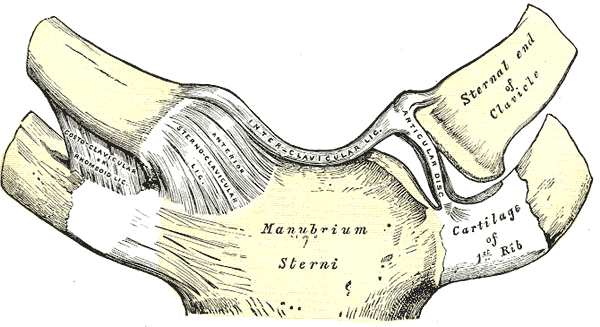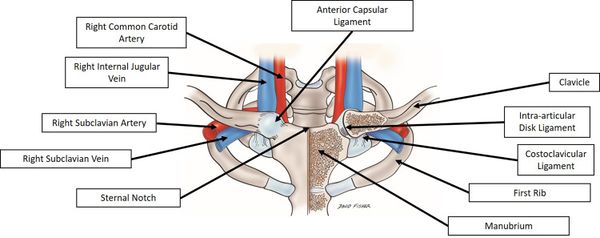Sternoclavicular Joint

| |
| Sternoclavicular Joint | |
|---|---|
| Primary Type | Saddle Joint"Saddle Joint" is not in the list (Synovial Joint, Cartilaginous Joint, Fibrous Joint, Compound Joint) of allowed values for the "Has joint type" property. |
| Secondary Type | |
| Bones | Clavicle, Rib 1, Manubrium |
| Ligaments | Sternoclavicular, costoclavicular, interclavicular ligs. |
| Muscles | |
| Innervation | Medial supraclavicular (C3-4) and subclavian (C5-6) nn. |
| Vasculature | Internal thoracic and suprascapular aa. (branches of the subclavian a.) |
| ROM | 35° in the horizontal and coronal planes, 70° range of motion anteroposteriorly, 50° of rotation along its long axis. |
| Volume | |
| Conditions | Sternoclavicular Joint Pain and Instability |
The sternoclavicular joint (SCJ) is a diarthrodial, multi-axial joint, and consists of the articulation between the manubrium sterni, the proximal clavicle, and the cartilage of the first rib. The medial clavicle is enlarged, bulbous, and saddle-shaped. The clavicular notch of the sternum is concave. Less than half of the medial clavicle articulates with the sternum. The articular surfaces are covered by hyaline cartilage. The joint has an intraarticular disc or meniscus that is made of fibrocartilage that divides the joint into two cavities. It is attached to the joint capsule anteriorly and posteriorly, first costal cartilage inferiorly and the clavicle superiorly.
Joint Stability
With limited osseous restraint and less than half of the medial clavicular surface articulating with the corresponding articular facet on the sternum, one would think that the joint is unstable. However it is actually quite strong with stability being provided by the following ligaments, and to a lesser extent muscular attachments.
| Ligament | Description | Function |
|---|---|---|
| Sternoclavicular ligament | This consists of the anterior, posterior, superior, and inferior sternoclavicular ligaments. It attaches the manubrium sterni to the clavicle | The posterior component, provides primary anteroposterior stabilisation of the SCJ. The anterior ligament also stabilises the SCJ and prohibits excessive superior displacement |
| Costoclavicular ligament | Attaches the cartilage of the first rib to the clavicle. Twisted cord like appearance. | Mediates bilateral clavicle and anterior first rib stability. By anchoring the inferior surface of the sternal end of the clavicle to the first rib, it serves as the primary restraint for the SCJ. Anterior portion resists upward rotation and lateral clavicular movement. Posterior portion resists downward rotation and medial clavicular movement. |
| Interclavicular ligament | Attaches the proximal end of one clavicle to the other. It also attaches to the superior manubrium sterni. | Facilitates medial traction of both clavicles, resisting upward movement of the medial clavicle in response to axial load to the shoulder and distal clavicle. |
| Intra-articular disc | Dense and fibrous. Originates from the chondral joint of the first rib, passes vertically through the SCJ creating two distinct joint areas. Attachments on both the superior and posterior clavicular aspects. Integrates with the capsular ligament | Resists medial displacement upon compressive forces applied to the clavicle. |
| Capsular ligament (anterior and posterior) | Thickenings around the joint capsule which enshrouds the external portion of the SCJ. | Most important structure in resisting upward movement of the medial clavicle in response to axial load placed on the distal clavicle. Anterior and posterior stability. |
The subclavius muscle also functions to provide joint stability. The subclavius muscle has a tendinous origin from the first rib just lateral to the costoclavicular ligament. It's insertion is onto the inferior surface of the clavicle. It acts to reduce the rate and range of upward displacement of the clavicle when under lateral compressive loads. It is a shock-absorber, reducing the strain placed on the SCJ.
Biomechanics
The SCJ is one of five articulations that allow fluid shoulder girdle movement. It provides 35° range of motion for movement in the horizontal and coronal planes and 70° range of motion antero-posteriorly. It also provides 50° of rotation along its long axis. Movement of the shoulder girdle influences movement of the SCJ. With humeral elevation of up to 90°, there is 4° of clavicular elevation about the SCJ with every 10°of humeral elevation. Rigid fixation of the SCJ therefore results in inadequate mobility.
SCJ motion primarily depends on the motion of the scapula and shoulder girdle, including the clavicle. Muscles that insert on the clavicle that influence SCJ movement are the deltoid, pectoralis major, trapezius, and sternocleidomastoid muscles.
| Motion | Muscles | Innervation |
|---|---|---|
| Elevation | levator scapulae, upper trapezius, rhomboid major and minor muscles | dorsal scapular nerve, C5 ventral ramus, C3-C4 ventral rami |
| Depression | pectoralis minor, lower trapezius, serratus anterior and inferior muscles | medial pectoral nerve, spinal accessory nerve, long thoracic nerve |
| Protraction | pectoralis minor, serratus anterior muscles | medial pectoral nerve, long thoracic nerve |
| Retraction | middle trapezius, latissimus dorsi, rhomboid major and minor muscles | spinal accessory nerve, thoracodorsal nerve, dorsal scapular nerve |
| Rotation via elevation of the glenoid cavity | upper and lower trapezius, serratus anterior and inferior muscles | suprascapular nerve, axillary nerve, long thoracic nerve |
| Rotation via depression of the glenoid cavity | levator scapulae, latissimus dorsi, pectoralis minor, rhomboid major and minor muscles | dorsal scapular nerve, thoracodorsal nerve, medial pectoral nerve, dorsal scapular nerve |
Relations
There are several vital structures directly posterior to the SCJ. This includes the brachiocephalic trunk, internal jugular vein, common carotid artery, vagus nerve, phrenic nerve, trachea, and oesophagus. These structures may be as close as 1mm to the joint. They are susceptible to injury with posterior dislocation and surgical procedures.
Variants
In a small portion of cases there is a facet that articulates with the first rib.
Age Changes
The clavicle is the first bone to ossify, and this occurs in the fifth week of gestation. Meanwhile, the medial physis of the clavicle is the last to fuse, with this occurring between the ages of 23 and 25 years. This makes diagnosing traumatic SCJ instability difficult in younger individuals. Some injuries are misdiagnosed as SCJ dislocations, where they are in fact, medial physeal fracture-separations. The intra-articular disc degenerates over time, and by the seventh and eighth decades it is frequently incomplete.
See Also
References
- Epperson & Varacallo. Anatomy, Shoulder and Upper Limb, Sternoclavicular Joint. 2021. . PMID: 30725943.
- Garcia et al.. Sternoclavicular Joint Instability: Symptoms, Diagnosis And Management. Orthopedic research and reviews 2020. 12:75-87. PMID: 32801951. DOI. Full Text.
- Sewell et al.. Instability of the sternoclavicular joint: current concepts in classification, treatment and outcomes. The bone & joint journal 2013. 95-B:721-31. PMID: 23723264. DOI.


